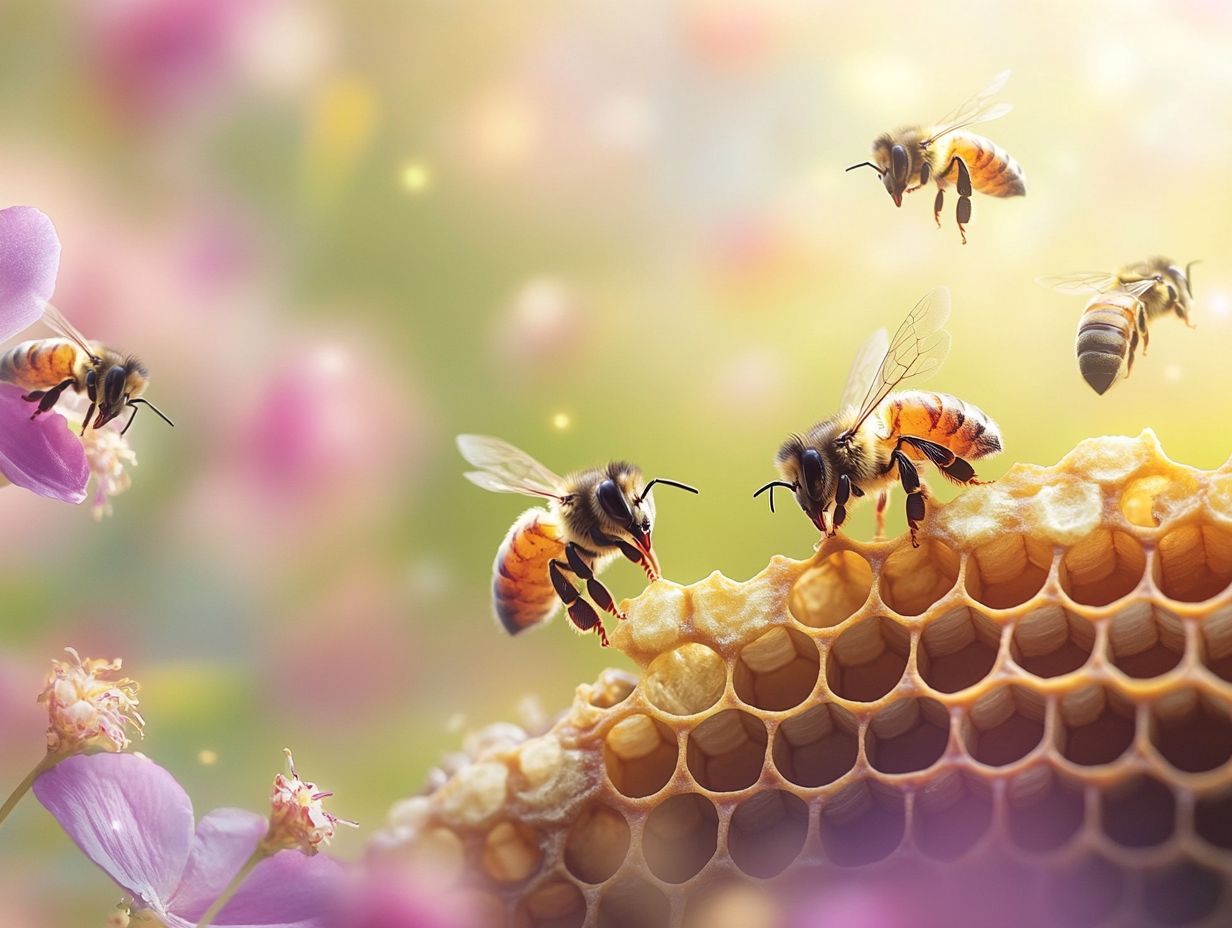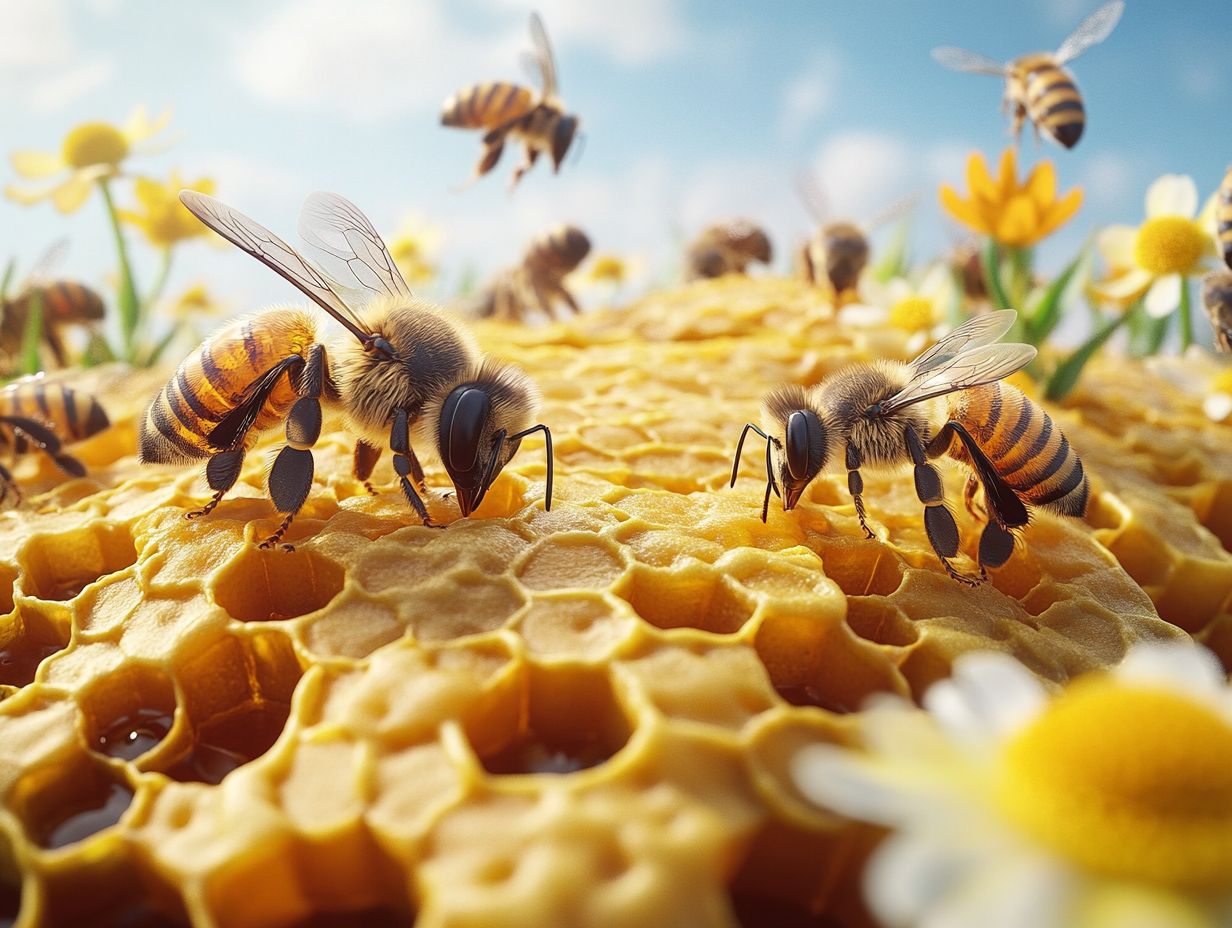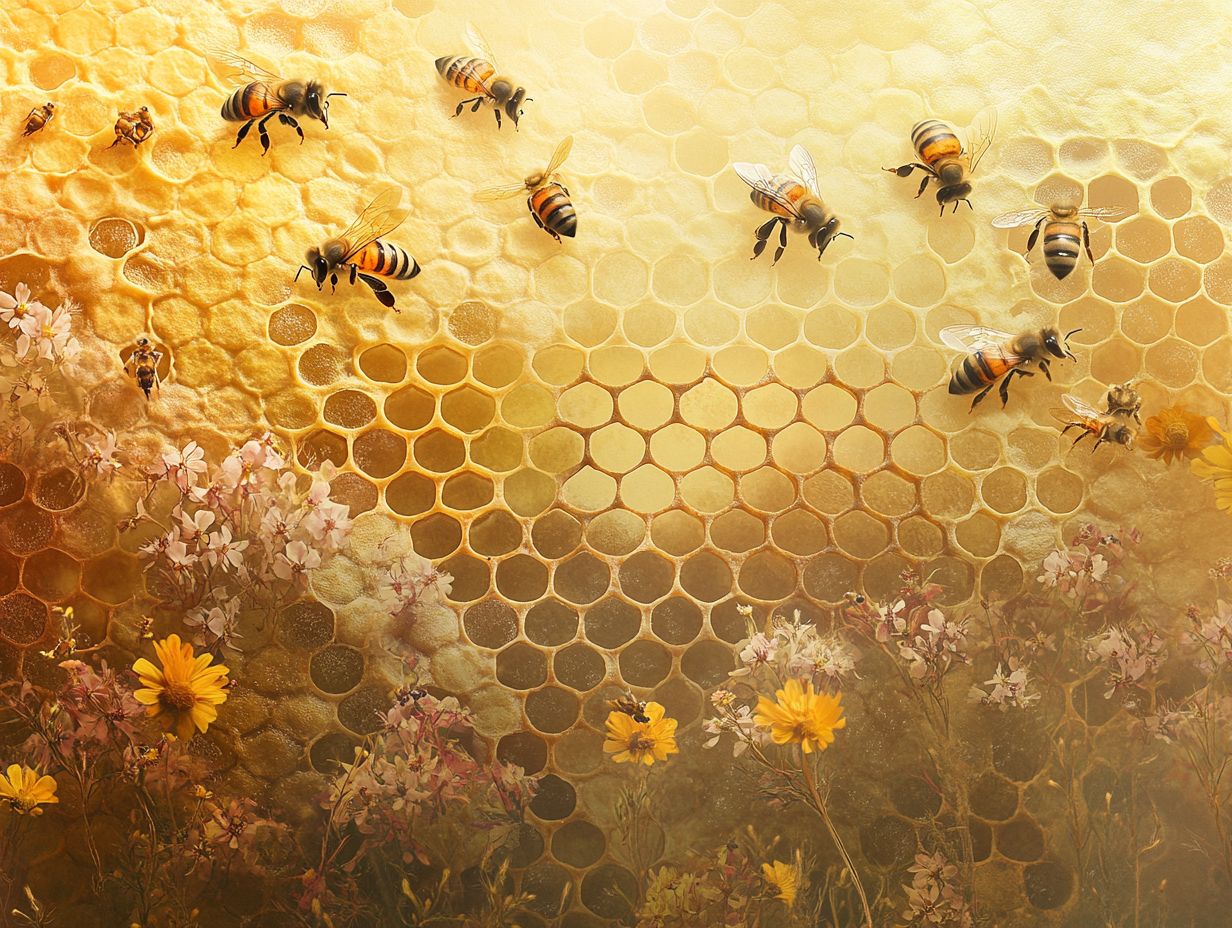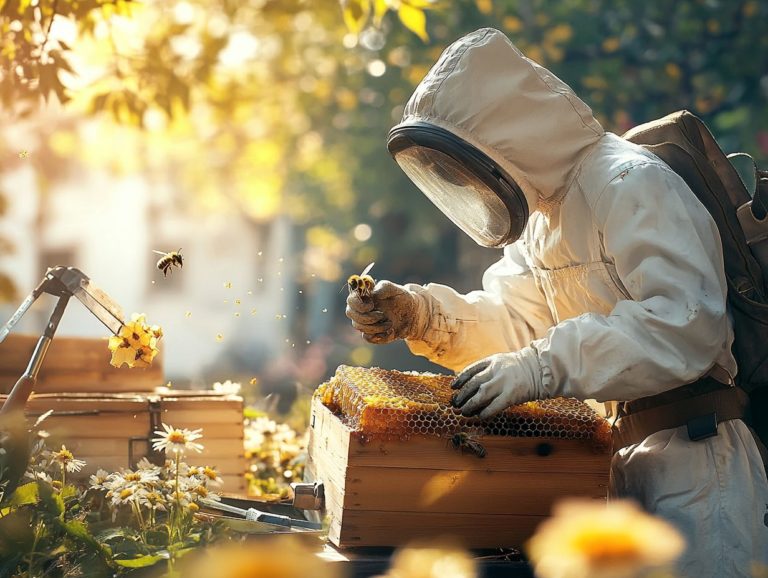Understanding the Bee Life Cycle and Hive Management
Bees are indispensable to our ecosystem. Many may not fully appreciate the intricacies of their fascinating life cycle or the importance of effective hive management.
In this article, you will explore the various stages of a honey bee’s life and understand the significance of maintaining healthy hives. You will also discover practical tips tailored for beekeepers.
It will also cover common challenges encountered in hive management. Beekeepers can play a pivotal role in bee conservation.
Join us as we explore the intricate world of bees and their essential contributions to our environment, including pollination and genetic variability.
Contents
- Key Takeaways:
- What is the Life Cycle of a Bee?
- Why is Hive Management Important?
- How to Manage a Beehive?
- What Are the Common Challenges in Hive Management?
- How Can Beekeepers Help in the Conservation of Bees?
- Frequently Asked Questions
- How does the bee life cycle influence effective hive management?
- How long does each stage of the bee life cycle last?
- What is the role of worker bees in the bee life cycle and hive management?
- How does queen bee selection affect hive management?
- What is swarm prevention and why is it important in hive management?
- What are some common challenges in understanding the bee life cycle and hive management?
Key Takeaways:

- Proper hive management is crucial for the health and productivity of a bee colony.
- Regularly inspecting hives and monitoring for pests and diseases can prevent common challenges like colony collapse disorder and varroa mite infestations.
- Beekeepers can play a crucial role in conserving bees by planting bee-friendly plants, avoiding pesticides, and participating in citizen science projects.
What is the Life Cycle of a Bee?
The life cycle of a honey bee is a captivating journey that encompasses several developmental stages: from egg to larva, pupa, and ultimately to adulthood.
This process is vital for the beehive’s functioning. The colony consists of a queen bee, worker bees, and drone bees, each with unique roles.
By understanding this life cycle, you can gain a deeper appreciation for the complex dynamics of these remarkable social insects, whether you re a beekeeper or simply an enthusiast.
What Are the Stages of a Bee’s Life Cycle?
A honey bee’s life cycle unfolds in four remarkable stages: the egg, larva, pupa, and adult stages, each playing a crucial role in the bee’s overall development. You begin as a fertilized egg, transforming into a larva nourished by royal jelly a special food for young bees and bee bread, a mix of pollen and honey, before entering the pupa stage, where big changes happen.
Eventually, the adult stage arrives, witnessing the emergence of fully developed bees, poised to contribute to the hive’s activities.
Your fascinating journey starts when the queen delicately lays eggs in hexagonal wax cells within the honeycomb. After about three days, each egg hatches, giving life to tiny larvae that are quite vulnerable.
During the larval stage, lasting approximately six days, you enjoy a nutrient-rich diet of royal jelly and bee bread, fueling rapid growth.
Then comes the pupa stage, a transformative period where you’re sealed in your cell and undergo metamorphosis the transformation that insects undergo as they develop sprouting wings and legs while chemical pheromones guide your development.
After approximately two weeks in this sealed sanctuary, you break free as a fully formed adult bee, ready to integrate into your colony and take on essential roles like foraging duty, hive maintenance, and reproduction.
Why is Hive Management Important?
Hive management is essential for you to maintain the health and productivity of your bee colonies, creating optimal conditions for honey production, colony strength, and hive organization. By employing effective management practices, you can monitor the health of your bees, prevent diseases, and bolster colony dynamics, ultimately enhancing the sustainability of your beehive.
You must monitor the health of your bees regularly. When you grasp and implement proper hive management techniques, you not only support the well-being of your bees but also contribute to vital ecological processes like pollination.
What Are the Benefits of Proper Hive Management?
Proper hive management presents a wealth of benefits that can significantly impact both honey production and the overall health of your bee colony. By adopting strategies that enhance brood rearing (the care of baby bees) and queen development, you can cultivate a robust colony that thrives in varying environmental conditions. A well-organized hive boosts foraging efficiency and leads to increased honey yields, creating a win-win situation for you and your bees.
When you manage your hive effectively, you foster a balanced ecosystem where bees can communicate, forage, and reproduce with ease. This environment promotes healthier colonies that are more resilient against diseases and pests, ultimately extending the life of your hive.
Ensuring optimal queen development is crucial. It guarantees a steady supply of worker bees essential for nectar collection and hive maintenance. With well-equipped bees, honey production can see a notable increase, allowing you to relish the fruits of your labor.
The principles of proper hive management not only cater to the immediate needs of the colony but also establish a solid foundation for sustainable success in your apiary endeavors.
How to Manage a Beehive?
Effectively managing a beehive demands a blend of careful practices, such as conducting regular hive inspections and keeping a vigilant eye out for pests and diseases. Harvest honey at just the right moment. As a successful beekeeper, you ll appreciate the importance of maintaining hive organization while ensuring that the colony dynamics remain balanced this is key to fostering healthy growth and productivity.
Every management task you undertake is crucial in supporting the hive’s overall functioning and safeguarding the well-being of its inhabitants. This includes monitoring brood patterns and being mindful of environmental control to ensure optimal conditions.
1. Choosing the Right Location

Choosing the right location for your beehive is essential for creating optimal conditions for your bee colonies and boosting their productivity. Consider factors like sunlight exposure, wind protection, and access to pollen sources. These elements significantly impact the health of your bees and their foraging efficiency. An ideal site facilitates environmental control, allowing your bees to thrive while ensuring the hive operates effectively.
As you select a location, don t overlook the importance of proximity to water sources. Bees require hydration for essential activities, so ensure they have access to water immediately! The terrain is another crucial factor; placing your hives on elevated ground offers better air circulation, helping minimize the risk of diseases. Nearby flowering plants fulfill the bees nutritional needs and maximize honey production. The presence of diverse pollen grains also aids in cross-pollination, which is vital for ecological balance.
When you bring all these elements together, you create a harmonious environment that supports a robust and productive beehive.
2. Providing Adequate Shelter
Providing adequate shelter for your beehives is essential to protect your bee colonies from harsh environmental conditions and potential threats. A well-designed beehive offers insulation, ventilation, and protection from pests. This allows the bees to concentrate on their vital tasks, such as foraging and caring for baby bees. Proper hive protection fosters a stable environment that enhances colony strength and overall health.
Discover how different designs and materials can supercharge your hive’s shelter! For example, wooden hives are a popular choice due to their natural insulation properties. Alternatives like polystyrene or straw bale structures can offer excellent thermal regulation. Elevated hive stands enhance drainage and reduce moisture accumulation, which is vital for the bees’ well-being. Incorporate windbreaks like shrubbery or fences to shield the hives from strong winds and direct harsh sunlight.
Ensuring proper shelter aids in maintaining a balanced ecosystem, where bees can perform tasks like foraging and feeding larvae effectively. By paying attention to these sheltering aspects, you can ensure the vitality and productivity of your colonies.
Start implementing these management tips today to boost your bee colonies health and productivity!
3. Regularly Inspecting the Hive
Regularly inspecting your hive is an essential practice that allows you to keep a watchful eye on its health! You can assess the brood pattern and spot any signs of disease or distress within your bee colonies. These inspections offer valuable insights into how the hive is functioning, enabling you to make informed decisions about necessary interventions or management changes.
By keeping a close eye on the hive, you can effectively support the growth and productivity of your colony. When conducting a typical inspection, start by carefully removing the hive’s lid, making sure not to agitate the bees too much.
It s crucial to check the brood frames for a consistent and healthy brood pattern, as this indicates a strong queen and successful reproduction. Pay attention to the presence of healthy larvae and eggs, including worker larvae and drone larvae, as they are equally important.
You should also be diligent in searching for any signs of disease, such as unusual discoloration or foul odors, which could signal potential threats to the colony’s well-being. Assessing the overall population of the colony is vital to ensure there are enough worker bees to sustain activity and foraging.
By focusing on these key areas, you can manage effectively and maintain robust bee populations.
4. Monitoring for Pests and Diseases
To maintain healthy bee colonies, monitoring for pests and diseases is vital. Stay alert to common threats like Varroa mites and other pathogens that can disrupt hive dynamics and weaken the colony. Adopting effective disease prevention strategies is crucial for sustaining strong, productive hives that can thrive in their environments.
Understanding the life cycle of these pests is essential to mitigate their impact. Regular inspections are key to the early detection of infestations and infections, allowing you to take prompt action.
By utilizing integrated pest management (IPM) techniques, a method to control pests using various strategies, such as applying sticky boards to monitor Varroa populations, you can adopt a proactive approach to maintaining hive health. This method focuses on knowing when pests are most vulnerable.
Fostering a robust bee colony through proper nutrition and genetic diversity serves as a natural defense against diseases. When outbreaks do occur, you can employ treatments like organic acids or essential oils to minimize chemical exposure while controlling these threats effectively.
Understanding the life expectancy and developmental stages of bees can help in better hive management. For more insights, check out this resource on understanding the lifecycle of honey bees. Implementing these methods not only strengthens individual hives but also contributes to the overall health of pollinator populations in the ecosystem.
5. Harvesting Honey
Harvesting honey is the gratifying reward for your dedication as a beekeeper, embodying the fruits of the labor of bees and your successful hive management. This meticulous process requires you to gently remove honeycomb frames filled and capped with wax, a process known as wax capping, all while ensuring minimal disruption to the colony and encouraging ongoing production.
Understanding the optimal timing and techniques for honey harvesting is crucial for maximizing yield while keeping your colony healthy. Choosing the right moment for harvesting is essential; late summer or early fall typically serves as the perfect window when nectar sources are dwindling, giving the bees ample time to produce excess honey.
Armed with the proper tools a bee suit, smoker, and uncapping knife you can work efficiently and calmly, minimizing stress for the bees. The role of worker bees during this period is crucial as they continue their foraging duty and food collection to maintain hive stability.
As you approach the hive, a gentle puff of smoke can soothe the bees, facilitating a smoother extraction process. Inspect the frames for readiness, looking for capped cells as your sign of fully ripened honey.
By employing gentle techniques during extraction, like using a honey extractor instead of crushing the comb, you ll help preserve the bees home. This sustainable harvesting method allows your hive to thrive for many seasons to come. Ensuring proper honeycomb integrity is key to maintaining colony survival.
With the right techniques, you can enjoy the sweet rewards of your hard work!
What Are the Common Challenges in Hive Management?
Navigating the common challenges of hive management is crucial for maintaining the health and productivity of your bee colonies. As a beekeeper, it s essential to stay informed about the pressing issues at hand.
Among the most significant concerns are Colony Collapse Disorder (CCD), infestations of Varroa mites, and various honey bee diseases that can jeopardize your hives. Understanding and addressing these challenges can enhance your hive management practices and contribute to the sustainability of beekeeping.
1. Colony Collapse Disorder

Colony Collapse Disorder (CCD) causes adult honey bees to suddenly abandon their hive, leaving the queen and brood behind. This poses a serious threat to bee health and can destabilize honey production.
Many factors, including pests and diseases, contribute to CCD. Exposure to pesticides, nutritional deficiencies, climate change, and the stresses of migratory beekeeping weaken colonies, making them more vulnerable to infections like nosema or the notorious varroa mite.
To reduce these risks, monitor your hives closely and provide them with a diverse range of food sources. Taking these proactive steps can boost your hive’s strength and help our bee populations thrive!
Ensure your queen bee is healthy and laying fertilized eggs. This leads to a strong brood pattern. Deploying nurse bees for bee larvae care and ensuring a consistent supply of royal jelly can further maintain colony strength.
2. Varroa Mites Infestation
Varroa mites are among the most formidable foes facing honey bee colonies today. They wreak havoc on bee health and colony dynamics. These parasitic mites feast on bee blood, leading to weakened colonies, diminished honey production, and increased vulnerability to diseases. For you, implementing effective pest management strategies is essential for controlling Varroa mite infestations and ensuring the longevity of bee populations.
The life cycle of these mites is particularly alarming. They reproduce within the brood cells, making their presence all the more insidious. Infected bees may display troubling symptoms such as abnormal wing development, shortened lifespans, and an overall weakened immune system. If these issues aren’t fixed quickly, they can ultimately lead to colony collapse.
To effectively combat these pests, you must adopt a plan that combines different ways to control pests, which includes:
- Regular monitoring
- Chemical treatments
- Cultural practices like drone brood removal
By understanding and addressing the challenges posed by Varroa mites, including their mating process and reproduction within drone cells, you have the power to protect honey bee populations and make a difference! This contributes to a healthier ecosystem.
3. Honey Bee Diseases
Honey bee diseases present a serious threat to the well-being of bee colonies. Various pathogens jeopardize their survival and productivity. Diseases such as American foulbrood and Nosema can wreak havoc on hive populations if not addressed with effective prevention and management strategies. Understanding these honey bee diseases is essential for maintaining colony health and ensuring sustainable beekeeping practices.
Take American foulbrood, for instance. This bacterial infection primarily targets the larvae, emitting a foul odor when the infected brood is present. On the other hand, there’s Nosema, a microsporidian a type of tiny organism that can make bees sick that infects adult bees, leading to dysentery and diminished performance. Transmission often occurs via contaminated equipment or when bees forage on infected plants.
To tackle these issues, treatments typically include proper hive management, which involves keeping the hive clean and organized, regular inspections, and, when necessary, antibiotics or other tailored interventions. By recognizing the symptoms and implementing proactive measures, you can significantly reduce the spread of these diseases and foster healthier hives.
The role of nurse bees in larvae feeding and overall brood rearing is crucial in maintaining colony strength.
How Can Beekeepers Help in the Conservation of Bees?
As a beekeeper, you hold a vital position in the conservation of bees. You champion practices that elevate the health and sustainability of these essential populations.
By cultivating bee-friendly plants, minimizing pesticide use, and embracing sustainable agricultural methods, you can foster a nurturing environment for bees. Your dedicated efforts not only support the well-being of the bees but also enrich the broader ecosystem, enhancing pollination and promoting biodiversity.
1. Planting Bee-Friendly Plants
Planting bee-friendly plants is a powerful way for you to support honey bee populations. These plants offer essential nectar sources and habitats for foraging. Carefully selected plants enhance local biodiversity and contribute to the overall health of bee colonies by ensuring a steady food supply throughout the seasons.
By choosing a diverse array of flowering plants, you can maximize pollination opportunities and cultivate a thriving environment for bees. These species will also attract not only honey bees but also a range of native pollinators, all of which play a crucial role in maintaining ecological balance.
Plants like lavender, sunflowers, and goldenrod are particularly advantageous, as they bloom at different times, providing a continuous food source year-round. Incorporating native flowering plants into your landscape not only aids in bee conservation but also promotes habitat restoration, helping to establish a native ecosystem that can adapt to environmental changes.
Additionally, these plants assist in cross-pollination, thereby improving the genetic diversity of various species. Therefore, making informed landscaping choices can profoundly impact the health and longevity of pollinators.
2. Avoiding the Use of Pesticides
Avoiding pesticides is crucial for honey bee safety. Exposure to these chemicals can severely impact their health and longevity.
By choosing alternative pest management strategies and promoting sustainable agricultural practices, you can create a safer environment for your bees while contributing to healthier ecosystems.
This commitment to bee safety protects your hives and fosters a sustainable approach to agriculture. Employing natural deterrents and biological controls helps reduce chemical exposure to bees.
Recognizing the intricate relationships between bees, crops, and the environment highlights the significance of these practices. For example, implementing integrated pest management (IPM) a strategy that combines different methods to control pests while reducing chemical use allows you to effectively curb pest populations while minimizing dependence on harmful chemicals, thus safeguarding colony survival and promoting genetic variability.
Planting bee-friendly flowers and providing natural habitats will bolster the resilience of bee populations against pests and diseases. Embracing organic farming, with its emphasis on natural fertilizers and non-toxic pest control methods, further plays a vital role in safeguarding bee health and supporting brood rearing.
By adopting these practices, you not only protect your bees but also contribute to a more vibrant and biodiverse agricultural landscape, fostering robust hive functioning and improving pollination efficiency. Join the movement to protect bees today! Your actions can make a difference.
3. Participating in Citizen Science Projects

Participating in citizen science projects presents you with a remarkable opportunity to contribute to bee conservation efforts and actively engage with your community. These projects often require you to collect data on bee populations, behaviors, and health, as well as on factors such as colony dynamics and environmental control. This information is critical for researchers and conservationists.
By getting involved, you can help elevate awareness regarding the importance of bees and the myriad challenges they face in today s environment. Your involvement deepens your understanding of bee ecology while nurturing valuable relationships within your community through shared knowledge and experiences.
You can document your observations, share insights about local bee species, including Apis mellifera liguistica, and partake in workshops designed to educate the public on pollinator conservation.
Each contribution, no matter how small, plays a pivotal role in creating a collective data repository that can inform effective conservation strategies. As you engage in citizen science, you help protect essential ecosystems and inspire others to appreciate and support local biodiversity.
Frequently Asked Questions
How does the bee life cycle influence effective hive management?
The bee life cycle refers to the stages of development that bees go through in their lifespan. This includes the egg, larva, pupa, and adult stages. Understanding the bee life cycle, including the roles of worker bees, drone bees, and queen bees, is important for effective hive management, as each stage requires specific care and attention.
How long does each stage of the bee life cycle last?
The egg stage lasts for 3 days, the larva stage for 6 days, the pupa stage for 12 days, and the adult stage can vary from several weeks to several months depending on the type of bee. It is important for beekeepers to know the duration of each stage, including the egg-laying process and egg hatching, to properly manage their hives.
What is the role of worker bees in the bee life cycle and hive management?
Worker bees are responsible for most of the tasks in the hive, including caring for the queen, collecting nectar and pollen grains, and building and maintaining the hive. They also engage in tasks such as foraging duty and cell capping. Understanding the specific roles of worker bees can help beekeepers make informed decisions about hive management and ensure effective hive organization.
To learn more about how you can support bee conservation efforts, consider getting involved in local initiatives!
How does queen bee selection affect hive management?
The queen bee lays eggs and maintains the colony. During mating flights, she mates with drones to store sperm for future egg-laying.
Beekeepers must select a healthy queen to ensure hive success. Proper queen management includes overseeing her development and ensuring she produces a strong brood pattern.
What is swarm prevention and why is it important in hive management?
Swarm prevention includes techniques to stop bees from leaving the hive. This is crucial because a swarm can drastically reduce the population and honey production.
Effective prevention involves monitoring brood patterns and ensuring there is enough space in the hive. Beekeepers need to manage their hives actively to prevent swarming.
What are some common challenges in understanding the bee life cycle and hive management?
Common challenges in understanding the bee life cycle include weather, disease control, and providing proper nutrition. Beekeepers must adapt to these challenges to manage their hives successfully.
This includes recognizing the roles of nurse bees in feeding larvae and the importance of royal jelly for queen development.
Start implementing these strategies today for a healthier, more productive hive!






